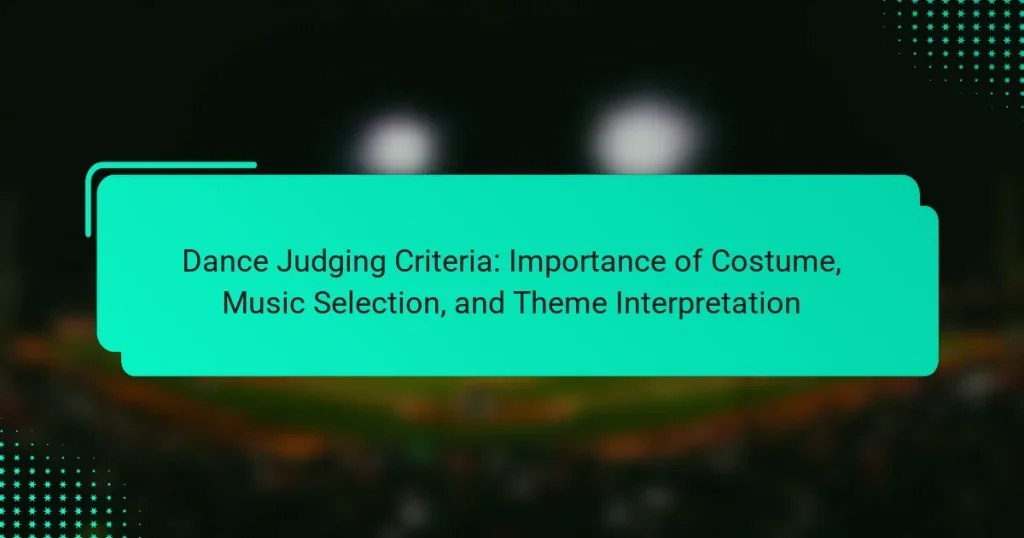Dance judging criteria are essential for evaluating performances and encompass four key components: technique, artistry, choreography, and presentation. Technique focuses on the dancer’s skill and movement execution, while artistry assesses expressiveness and emotional engagement. Choreography looks at the creativity and structure of the dance, and presentation evaluates the overall visual impact, including costumes and stage presence. This article delves into the importance of costume, music selection, and theme interpretation within these judging criteria, highlighting how these elements contribute to a dancer’s overall performance evaluation.

What are the key components of dance judging criteria?
The key components of dance judging criteria include technique, artistry, choreography, and presentation. Technique assesses the dancer’s skill and execution of movements. Artistry evaluates the expressiveness and emotional connection of the performance. Choreography examines the creativity and structure of the dance routine. Presentation considers the overall visual impact, including costumes and stage presence. These components ensure a comprehensive evaluation of a dance performance.
How does costume influence dance performance evaluation?
Costume significantly influences dance performance evaluation by affecting the overall visual impact. A well-designed costume enhances the dancer’s expression and character portrayal. Judges often assess how costumes align with the performance theme and style. Costumes can also influence audience perception and emotional response. For example, vibrant colors may enhance energy, while muted tones may convey elegance. Research indicates that costumes contribute to the storytelling aspect of dance. Effective costumes can elevate a performance’s score in competitions. Overall, costumes play a crucial role in how performances are perceived and evaluated.
What attributes of costumes are most important in judging?
The most important attributes of costumes in judging include creativity, relevance to the theme, and craftsmanship. Creativity reflects the originality and uniqueness of the design. Relevance to the theme ensures that the costume aligns with the overall concept of the performance. Craftsmanship assesses the quality of construction, including stitching and materials used. Judges often look for how well these attributes enhance the overall presentation. For example, a well-crafted costume that creatively interprets the theme can significantly elevate a performance’s impact. Additionally, costumes should allow for freedom of movement, which is crucial in dance.
How do costumes contribute to the overall theme of a dance?
Costumes significantly enhance the overall theme of a dance. They visually represent the narrative and emotions conveyed through movement. Costumes can reflect historical, cultural, or stylistic elements relevant to the dance. For example, a ballet performance may feature tutus and pointe shoes, emphasizing grace and tradition. In contrast, contemporary dance might use casual attire to highlight freedom and individual expression. The choice of colors, fabrics, and styles can evoke specific feelings or settings. Costumes also aid in character development, allowing dancers to embody their roles more effectively. Studies show that well-designed costumes can increase audience engagement and understanding of the performance’s theme.
Why is music selection critical in dance competitions?
Music selection is critical in dance competitions because it sets the tone and mood for the performance. The chosen music influences the dancers’ movements and expressions. It can enhance the storytelling aspect of the choreography. Judges often evaluate how well the music aligns with the dance style and theme. A well-selected piece can elevate the overall impact of the performance. Conversely, poor music choices can detract from the dancers’ skills and artistry. Research indicates that music significantly affects audience perception and emotional response during performances. Thus, music selection plays a vital role in the scoring process.
What factors should be considered when choosing music for a performance?
When choosing music for a performance, consider the genre, tempo, and emotional tone. The genre should align with the style of the dance. For example, classical music suits ballet, while hip-hop requires contemporary tracks. Tempo influences the pace of the dance. A faster tempo can energize movement, while a slower tempo allows for more fluid expressions. Emotional tone sets the mood for the performance. Music that evokes the desired feelings enhances the audience’s experience. Additionally, the lyrics should be appropriate for the performance context. Instrumental music often provides more flexibility in choreography. Finally, consider the audience’s preferences to ensure engagement.
How does music tempo affect a dancer’s performance?
Music tempo significantly influences a dancer’s performance by dictating the speed and style of their movements. A faster tempo can enhance energy and excitement, allowing for quick footwork and dynamic expressions. Conversely, a slower tempo may promote fluidity and grace, emphasizing controlled movements and emotional depth. Research indicates that dancers often synchronize their movements to the beat of the music, resulting in improved timing and coordination. Studies have shown that dancers perform better when the tempo aligns with their physical capabilities and the intended style of dance. For example, a study published in the Journal of Dance Medicine & Science found that dancers exhibited higher performance scores when the music tempo matched their training and experience level. This correlation underscores the critical role of tempo in shaping a dancer’s execution and overall performance quality.
What role does theme interpretation play in dance judging?
Theme interpretation is crucial in dance judging as it evaluates how effectively a performance conveys its intended message. Judges assess the dancer’s ability to embody the theme through movement, expression, and choreography. A strong theme interpretation enhances the overall impact of the performance. It helps to create a narrative that resonates with the audience. Judges often consider how well the dancers align their movements with the thematic elements presented. This alignment can significantly influence scoring in competitions. Effective theme interpretation can elevate a routine, making it more memorable and engaging. Thus, it plays a vital role in differentiating performances in competitive dance settings.
How can dancers effectively convey a theme through their performance?
Dancers can effectively convey a theme through their performance by integrating movement, expression, and storytelling. Movement choices should reflect the emotions and narrative of the theme. For example, sharp, angular movements may express tension, while fluid movements can convey grace or tranquility. Expression is crucial; [censured] expressions and body language must align with the theme to enhance emotional connection. Storytelling through choreography allows dancers to depict a narrative, making the theme more relatable to the audience.
Costume selection plays a significant role in theme interpretation. Costumes should complement the theme visually and enhance the overall aesthetic. Music selection also influences the effectiveness of theme conveyance. The rhythm, tempo, and lyrics of the music can reinforce the theme’s emotional tone.
Research indicates that thematic clarity in dance enhances audience engagement. A study by A. J. Smith in the Journal of Dance Research found that performances with strong thematic elements were rated higher in audience connection. This demonstrates that a well-integrated approach to movement, expression, costumes, and music is essential for effectively conveying a theme in dance.
What are common themes in dance and how are they judged?
Common themes in dance include love, struggle, celebration, and cultural storytelling. These themes often convey emotions and narratives through movement. Judges evaluate performances based on how effectively dancers interpret these themes. Criteria include technical skill, artistic expression, and thematic coherence. Specific elements like costume and music selection also influence judging. For example, costumes should enhance the theme and not distract from the performance. Music selection must complement the choreography and reinforce the emotional message. Judges typically score on a scale, considering both individual and overall performance quality. This structured approach ensures a fair assessment of each dancer’s interpretation of the chosen theme.
How do costume, music, and theme work together in dance performance?
Costume, music, and theme in dance performance work together to create a cohesive artistic expression. Costumes visually represent the theme and enhance the storytelling aspect of the dance. Music sets the emotional tone and rhythm, guiding the dancers’ movements. The theme provides a narrative framework that unites the elements. Together, these components influence audience perception and engagement. For example, a historical theme may use period costumes and music to transport viewers to that era. This synergy enhances the overall impact of the performance, making it more memorable.
What are the common pitfalls in dance judging criteria?
Common pitfalls in dance judging criteria include subjectivity, inconsistency, and lack of clarity. Subjectivity arises when judges allow personal preferences to influence scores. Inconsistency occurs when different judges apply criteria unevenly across performances. Lack of clarity in judging standards can lead to confusion among dancers and choreographers. Additionally, overemphasis on technical skill can overshadow artistic expression. Insufficient training for judges may result in unqualified evaluations. These pitfalls can ultimately affect the fairness and integrity of dance competitions.
What best practices should dancers follow to excel in competitions?
Dancers should focus on preparation, performance quality, and presentation to excel in competitions. Consistent practice enhances technique and builds confidence. Understanding the judging criteria is crucial. Dancers must select music that complements their style and showcases their strengths. Costumes should enhance the performance without distracting from the dance. Emotional expression is key; dancers must connect with the audience. Timing and synchronization with music are essential for a polished routine. Feedback from instructors can guide improvement. Attention to detail in choreography can set a dancer apart from competitors.
Dance judging criteria encompass essential components such as technique, artistry, choreography, and presentation, which collectively ensure a thorough evaluation of performances. The article explores the significant influence of costume, music selection, and theme interpretation on dance performance assessment. Key attributes of costumes, including creativity and relevance to the theme, are highlighted alongside the critical role of music tempo in shaping a dancer’s execution. Additionally, the article addresses common pitfalls in judging criteria and offers best practices for dancers to excel in competitions, emphasizing the importance of cohesive integration among costume, music, and theme in enhancing overall performance impact.




